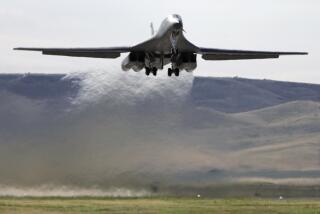House Panel Blames B-1 Problems on Shoddy Air Force Management
- Share via
WASHINGTON — Air Force mismanagement is to blame for the B-1 bomber’s apparent inability to penetrate Soviet defenses as originally promised by the Reagan Administration, the House Armed Services Committee concluded Monday.
In a report announced by panel Chairman Les Aspin (D-Wis.) and Rep. Samuel S. Stratton (D-N.Y.), who chairs the panel’s procurement subcommittee, the committee said that Congress cannot justify spending additional large sums of money on the $20.5-billion B-1 program because of doubts about the capabilities of the bomber and questions about the Air Force’s ability to manage it.
Almost Entirely to Blame
Although Aspin said that the bomber’s manufacturer, Rockwell International, bears some responsibility for failing to point out difficulties with the plane, the committee said the Air Force is almost entirely to blame for the B-1’s failure because it acted as its own primary contractor.
“In the bluntest of terms,” the committee said, “the United States Air Force has been a greater threat to the success of the B-1 bomber than the Soviet Union.”
In 1981, President Reagan revived the B-1 program, which had been canceled by President Jimmy Carter, on grounds that a more sophisticated bomber than the B-52 was needed until the stealth bomber is completed in the 1990s. At that time, the Air Force pledged that it could produce 100 B-1s at a fixed cost of $20.5 billion, given a minimum of “interference” from Congress.
Fifty-two B-1s have been delivered so far, and development of the bomber is believed to be at least two years--and perhaps as much as four years--behind schedule, according to the report.
Cites Hidden Costs
In addition, the committee charged that the Air Force has found ways to hide other costs and that some of the $2.6 billion sought for “enhancements” of the B-1 will actually be spent on original equipment. “Billions of dollars devoted to the B-1 were tucked into other programs,” the report said.
Although the program managers knew as early as October, 1982, that the B-1 would require additional modifications to perform according to the original specifications, the committee said, top Pentagon officials were not informed of the problems until the fall of 1985 and Congress was not told until January, 1987, when it received a request for an additional $800 million.
The committee said that the most serious problem with the B-1 involves the so-called “electronic countermeasures” that were supposed to allow the bomber by 1986 to penetrate enemy defenses without being detected. A three-stage program to upgrade these countermeasures will not be completed until January, 1991, at the earliest.
In addition, the committee cited fuel leaks, weight problems, an 80% false-alarm rate in the bomber’s internal diagnostic system and a severe shortage of spare parts.
Some of the B-1 problems were blamed on the “buy before fly” policy under which the bomber was developed and on a three-year slip in the B-1 test program. “The rush to production created an environment where delivery schedules became more important than assuring B-1 capability or maintaining program integrity with an adequate test schedule,” it said.
Turnover Adds to Problem
Frequent turnover in the military bureaucracy also contributed to the Air Force’s mismanagement, the report said, and the loss of skilled personnel at Rockwell is likewise having an impact on quality control and production quotas. As the program winds down, many production workers and engineers are leaving Rockwell to find employment elsewhere.
‘Missed Key Issues’
The committee noted that Defense Secretary Caspar W. Weinberger boasted during congressional testimony in 1984 that he was calling biweekly meetings to review the B-1 program, asking: “Are we on time and are we within or under budget?” But the report added: “The questions that were being asked--is it on time and within budget--missed the key issues of whether all the systems worked” and whether the B-1 could perform its mission.
The lesson of this experiment, according to the report, is that Congress cannot trust the military bureaucracy to procure new weapons systems without strict congressional control. As Aspin put it: “This is a top-shelf example of a non-micromanaged program . . . and, frankly, the Air Force screwed up.”
More to Read
Sign up for Essential California
The most important California stories and recommendations in your inbox every morning.
You may occasionally receive promotional content from the Los Angeles Times.










